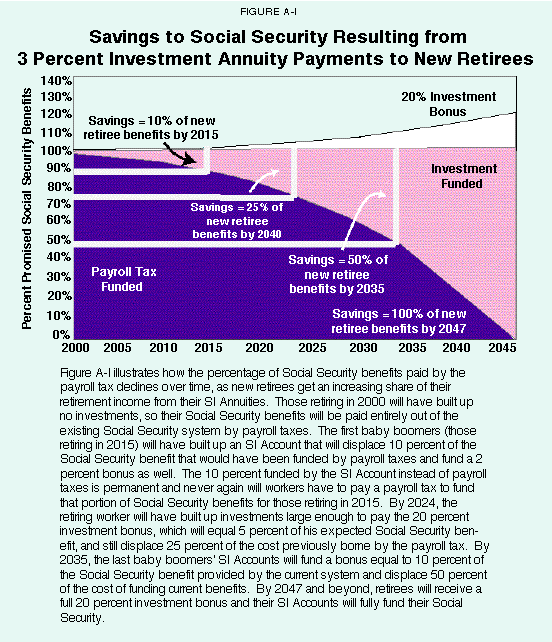The exploding cost of Social Security threatens to become the greatest financial crisis in American history. The unfunded liability of the system is twice as large as our national debt and exceeds the combined cost of all the wars fought in our nation's history. More than a financial crisis, the current Social Security system is fast becoming a human tragedy that will force us to choose between economic opportunity for our children and retirement security for our parents.
The cause of this crisis is a debt-based system of finance. Taxes taken from today's workers are not invested in real assets to fund their future retirement. Instead they are being used to pay the benefits of current retirees and to fund other government programs. When today's workers retire, they will have to depend solely on future taxpayers to fund their benefits. Yet because of a growing ratio of retirees to taxpayers, the tax burden on future wage earners will explode.
Now at the peak of their earning power, 77 million baby boomers are paying 60 percent of all payroll taxes collected in America. Soon they will cease paying into the system and start drawing benefits from it. Twenty years after the Baby Boom generation starts to retire, the retirement rolls will be growing almost 4 1/2 times as fast as the employment rolls. By that time, we will face the choice of increasing the payroll tax on working Americans by 33 percent or reducing every Social Security benefit check by 25 percent.
Fortunately there is a better way. We can begin now a 40-year transition to an Investment-Based Social Security system in which workers will be allowed to place a portion of their payroll tax dollars in private investment accounts which they own. In contrast to the current system, which makes no investments and earns no interest, workers will invest a portion of their payroll taxes in investment funds managed by professional money managers certified for safety and soundness and regulated by a new Social Security Investment Board. By making real investments and creating real wealth, the Investment-Based Social Security system will benefit from what Albert Einstein called the most powerful force in the universe, the power of compound interest. These funds will be invested conservatively in stocks and bonds that will grow as the economy grows. The resulting pension benefits will be larger and more secure than those promised under the current system. During the transition and under the new Investment-Based system no worker will lose any benefit currently provided by the Social Security system. The higher benefits of Investment-Based Social Security will phase in gradually as the total level of worker investment grows:
- The first baby boomers to retire will receive almost 10 percent of their retirement income from their Social Security investment accounts and 90 percent from the current Social Security system.
- The last baby boomers to retire will receive about 50 percent of their retirement income from their Social Security investments and about 50 percent from the current system.
- Today's 20-year-olds with average lifetime earnings will receive 100 percent of their retirement income from their Social Security investments and can expect to receive 20 percent more in benefits. Those who have low wages or who lose work time due to sickness or unemployment will have lost Social Security benefits made up out of the current system.
Investment-Based Social Security will have the following features:
Choice. All workers paying into the current Social Security system will have the right to continue to stay in the current system. As an alternative, they will have the right to participate in Investment-Based Social Security, to achieve greater security and higher benefits. All young workers entering the labor market for the first time will enter the new system.
Benefits secured for current retirees. The new, reformed system will begin to put Social Security on a sound financial footing, assuring that the federal government will be able to meet its commitments to all current retirees and to those who will retire in the future. Unlike most other reform plans, the Investment-Based Social Security reform plan guarantees that benefits for the elderly will not be reduced either directly or through such indirect means as raising the tax on benefits, lowering the cost-of-living adjustment, or raising the retirement age.
Higher benefits under the new system. Everyone who chooses to participate in the new system will be guaranteed a higher monthly pension than the one promised by the current system. Once fully implemented, the federal government will guarantee a pension 20 percent higher, but most retirees will do better than that. When fully implemented, young workers can look forward to Social Security pensions 2 1/2 times the size of those they would have received under the current system.
Benefits backed by real assets. Under the current system, the ability of the elderly to receive retirement benefits is totally dependent on the willingness of taxpayers to pay for those benefits. Under Investment-Based Social Security, by contrast, pension benefits will be secured by the real investments owned by the worker.
Benefits protected from politicians. The Supreme Court has ruled that people have no constitutionally protected right to Social Security benefits, even if they have paid Social Security taxes. As every Social Security retiree is painfully aware, benefits promised by one Congress can be revoked by a subsequent Congress. By contrast, investment accounts established by Investment-Based Social Security will be the worker's private property and will enjoy the full protection of the "takings" clause of the U.S. Constitution.
No new risk. Participants in Investment-Based Social Security retain all benefits guaranteed by the current system and can never be worse off than they would have been in the old system. As each worker's Social Security Investment Account grows, his retirement benefits grow larger and the ability of government to alter his benefits by changing the benefits paid under the old Social Security system declines.
New retirement options. At the time of retirement, people will be required to use the funds in their private investment accounts to purchase an annuity which will pay a monthly pension – equal ultimately to a minimum of 120 percent of the benefit promised under the current system. When the Investment-Based Social Security system is fully implemented, many people will have saved far more than the amount needed to purchase such an annuity. They will be free to use these savings to purchase a larger pension annuity, or to withdraw the extra funds as a lump sum and use them as they choose.
Freedom to retire. During a transition period, people will still be able to retire at the normal retirement age with a government-guaranteed minimum benefit. They will also be able to take early retirement at age 62, at the standard reduced government-guaranteed benefit. But once the new system is fully implemented, workers can choose when they want to retire, provided they have accumulated assets sufficient to pay a monthly pension equal to 120 percent of the benefit promised by the current system.
Freedom to work. Once the new system is fully implemented, people will also be free to continue working past their normal retirement age, without any loss of pension benefits. This is in contrast to the current system, under which retirees can lose $1 of benefits for every $3 of wages above a certain income level.
Inheritance rights. If a worker dies prior to retirement, a portion of the funds in that worker's private retirement account will be used to pay survivors benefits for a surviving spouse or other family members – equal to or better than those promised by the current system. All remaining funds will be bequeathed to the worker's heirs in one lump sum, free of all taxes.
The new Investment-Based Social Security system would be phased in over time:
- Beginning in the year 2000, workers will be able to place three percentage points of the 12.4 percent Social Security payroll tax into private investment accounts.
- By the year 2038, the new system will be saving Social Security more than it costs, and the percent of wages workers can put into their investment accounts can begin to rise.
- By 2055, workers will be able to put aside 10 percent of wages – 8 percent to fund their retirement and 2 percent to fund disability insurance.
- After 2065, the payroll tax will decline from the current 12.4 percent to 10 percent.
The transition to an investment-based system will require about 50 years, during which time existing benefits would not be cut and taxes would not be raised. In the interim, there will be a need for funds to finance the transition as we allow people to deposit a portion of their Social Security payroll taxes into investment accounts. Three sources of funds will finance the transition: (1) projected federal budget surpluses; (2) a recapture (for use by Social Security) of the federal corporate income taxes that will be collected on new investment made possible by the accumulation of capital in Social Security investment accounts; and (3) redemption of 29 percent of the Social Security Trust Fund's assets. The redemption of a portion of the Social Security Trust Fund will require the federal government to pay Social Security back 29 percent of what it has taken out of the system in the past to fund other government activities.
Saving Social Security requires that we save and invest now rather than tax and borrow later. And more than money is at stake. Save today and we save our children's dreams tomorrow. Invest today and we invest in our parents' security. Tax tomorrow and we diminish our children's future. Cut benefits tomorrow and we harden our parents' retirement.
[page]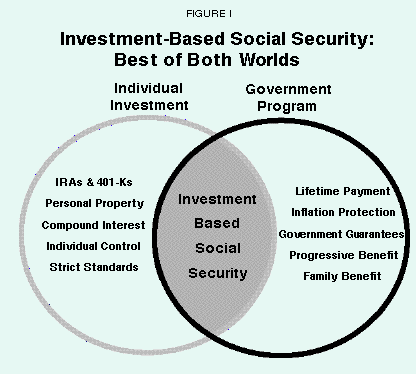
1If allowed to run its course, the exploding cost of Social Security is destined to become the greatest financial crisis in American history. The unfunded liability of the nation's largest entitlement program is twice the national debt, and if Social Security solvency is preserved simply by raising taxes and cutting benefits, the cost will exceed the combined cost of all the wars fought in our nation's history. The looming Social Security crisis is more than a financial crisis, it is a human tragedy that will force us to choose between economic opportunity for our children and retirement security for our parents.
"If allowed to run its course, the cost of Social Security will become the greatest financial crisis in American history."
The limit on benefit reduction imposed by the social fabric of the nation and the limit on payroll taxes imposed by the economic reality of a competitive world economy render benefit reductions and tax increases inadequate to meet the challenge. The solution lies instead in transforming our debt-based Social Security system into an investment-based system. We must take the best features of the current system and combine them with the time-tested principles of private saving and investment. [See Figure I.] In so doing we can produce a secure system that will provide benefits not only to our parents but to our children as well. In fact, Investment-Based Social Security achieves what Americans thought Social Security did all along – it helps us save during our working years to provide for our retirement years.
"By 2030, there will be only two workers for each retiree."
The Social Security Crisis. The imminent crisis in Social Security is best described by looking at the number of workers per retiree and how much each worker must pay in taxes to fund Social Security benefits. In 1937, 42 workers contributed 2 percent of their first $3,000 of wages to pay benefits for one retiree. By 1965, four workers were each being taxed 7.25 percent of the first $4,800 of wages to provide benefits for each retiree. Today, 3.3 workers are paying 12.4 percent of the first $68,400 of wages to take care of each retiree. By 2030, according to the 1998 Social Security Trustees Report, two workers will each have to pay 16.6 percent of the current law wage base to fund Social Security benefits for a single retiree. As the payroll tax spirals, the economic opportunity of children and grandchildren will be pitted against the financial security of their parents and grandparents and everyone will lose.
What Caused the Crisis? To understand how the current crisis in Social Security came about, it is helpful to look at the history of the transfer payment entitlement. Transfer payment funding of entitlements started in Germany in 1889 with a dramatic new program initiated by Chancellor Otto von Bismarck. While cloaking his program in the language of saving and investment, Bismarck taxed current workers to pay benefits to current retirees. The next generation would then be taxed to provide benefits for those currently working. Bismarck's system substituted a tax on the future earnings of unborn workers for the traditional system of saving and investment.
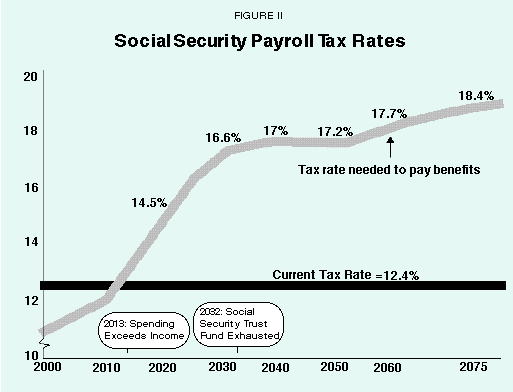
The transfer payment-funded entitlement has become the dominant social program in the world. The Bismarck system first spread throughout Europe and reached Australia in 1909. It came to the Americas in 1925 when Chile adopted the system. It arrived in the United States in the form of Social Security in 1935 and Medicare in 1965.
"The 77 million baby boomers now pay 60 percent of all payroll taxes; soon they will stop paying taxes and start drawing benefits instead."
All of the world's entitlement programs that rely on transfer payment funding have two problems in common: (1) they do not create any wealth or enjoy the miracle of growth through the enormous power of compound interest, and (2) they are held hostage to demographics. The remarkable increase in life expectancy and the collapse in the birth rate have driven down the ratio of workers to retirees and driven up the cost that transfer payments impose on workers. These trends, which have dominated the last third of the 20th century, show no signs of abating in the 21st century.
The Baby Boom Generation. These problems are illustrated in America's experience with the baby boom generation. There are 77 million people in America who were born between January 1, 1946 and December 31, 1964. That generation and the explosion in the work force it produced made Medicare possible and sustained Social Security far longer than the system could have survived without it. Baby boomers, now at the peak of their earning power, are paying 60 percent of the total payroll taxes collected in America. Over the next 30 years that figure will drop to less than 2 percent and the newly retired baby boomers will be demanding benefits the current system is incapable of providing. In the 20 years after the baby boom generation starts to retire, the retirement rolls will grow almost four-and-a-half times as fast as the employment rolls.
"None of the taxes paid into the Social Security system are set aside to pay future retirement benefits."
How Debt-Based Social Security Works. In 1935, when the United States Congress passed the Social Security Act, the debate was laced with references to the traditional practice of saving during one's working years to fund benefits in retirement. Americans were told that they would pay into the Social Security system to build up an investment fund that would finance their benefits in retirement. Sen. Pat Harrison of Mississippi, chairman of the Committee on Finance, which wrote the legislation, said that "besides the saving to the nation as a whole, the annuity system will give to the worker the satisfaction of knowing that he himself is providing for his old age."
Unfortunately, the legislation establishing Social Security never matched the rhetoric of the politicians who sold it. No investments were ever made. No wealth was ever created. No interest was ever earned.
Today, none of the taxes paid into the Social Security system are set aside to pay future retirement benefits to the worker whose paycheck is being reduced. Most of the money is used to provide benefits for today's retirees. The remainder is taken by the federal government and spent on other, totally unrelated programs. In fact, the federal budget is in surplus in 1998 only because the portion of Social Security taxes not used to pay for today's retiree benefits, $99 billion, more than offsets the $29 billion of deficit spending on other programs of the federal government.
"Under debt-based Social Security, we will have to choose between economic opportunity for our children and retirement security for our parents."
The current Social Security surplus has been accumulating since Congress reformed the system to prevent bankruptcy in 1983. By 2013, the Trust Fund surplus is projected to be $3.032 trillion. But in reality the annual surplus of Social Security taxes over Social Security benefit payments has been used to fund other government programs. The surplus simply made it possible for the federal government to spend more, tax less and borrow less than it otherwise would have. The Trust Fund is a notional bookkeeping device that is not counted as an external debt of the Treasury. When notional interest payments are made to the Trust Fund, they do not count as outlays of the federal government. The existence of the notional surplus provides no resources to enable the government to pay future Social Security benefits. To pay benefits at levels above the level of Social Security taxes collected in any given year, the federal government must do all the things it would be required to do if there were no Social Security IOUs: raise taxes, cut other spending or borrow from the public.
The Future of Debt- Based Social Security. The existing Social Security retirement system will require huge tax hikes in order to pay the benefits promised to the elderly. By 2013, Social Security will spend more each year than it takes in. In order to pay promised benefits, Congress will only have two options: (1) raise payroll taxes or (2) for a short while, cash in the IOUs which the government owes the Social Security Trust Fund, forcing the federal government to cut other programs, raise other taxes or borrow from the public. The second option would only delay the payroll tax hikes until 2032, when the Trust Fund IOUs would be exhausted. If the current Social Security system is left unchanged, the payroll tax rate will rise from 12.4 percent to 16.6 percent by 2032 and to 18.4 percent by 2075. [See Figure II.] When combined with rising Medicare costs, the payroll tax could double over the next 30 years.
"Twenty years after the baby boom generation starts to retire we will either have to increase payroll taxes on working Americans by 33
percent or reduce every benefit check by 25 percent."
The equally unpalatable alternative to imposing confiscatory payroll taxes is cutting benefits. To maintain Social Security solvency after 2032 requires a 25 percent reduction in benefits. Seventy-five-year solvency requires a 33 percent reduction in aggregate benefit levels. If unchanged, Social Security's current structure ultimately will force us to choose between massive tax increases that erode economic opportunity for our children and staggering benefit cuts that destroy our parents' retirement security.
[page]If the levels of benefit cuts and tax increases required to maintain the current pay-as-you-go system are not feasible, is there an alternative? The answer is yes. Here is why:
- If three percentage points of the current 12.4 percent payroll tax paid by 22-year-old workers were invested annually in earning assets (stocks and bonds) for the remainder of their working lives, the value of that investment would roughly equal the benefits a 22-year-old worker is currently promised by the Social Security system.
- The estimated average annual federal budget surplus over the next decade – $215 billion – will more than pay for the annual transition cost of allowing workers to opt into an Investment-Based Social Security system.
- An investment-based solution to the Social Security crisis has already been tested in other countries, and it works.
"Three percent of payroll invested annually would fund the same benefits currently promised to a 22-year-old worker by Social Security."
More than half a dozen countries have discarded the Bismarck system and replaced it in total or in part with an investment-based system. Australia did it under a left-leaning labor government; Britain did it first under a Labour Government and expanded it under Margaret Thatcher; and Chile did it as a developing country. In each case, benefits have become more secure and average retirement incomes have risen.
Creating an Individual Investment Alternative. On January 1 of the year 2000 every worker holding a Social Security card will be given a choice. They can enter the investment-based system or stay in the current system. Those acquiring a Social Security card after January 1, 2000, will automatically enter the new system. Those electing to remain in the current system can choose to enter the new system at any point during their working lives. Those entering the investment-based system will be guaranteed retirement, survivor, disability and other benefits at least equal to those the current system provides.
"Investment-Based Social Security would give all workers an option: Instead of paying 3 percent of wages to the government, deposit the
money into individually owned investment accounts."
All workers will continue to have 12.4 percent of their wages withheld by their employer. Just as under the current system, the employee will pay half of the withheld amount directly out of wages and half indirectly through the employer's contributions. But for those opting into the new system, three percentage points of that 12.4 percent will go not to pay benefits for current retirees or to fund general government but instead will be invested in real earning assets. Each worker will own his new investment account, which will be used solely to pay his retirement or survivor benefits.
Market Rates of Return. For the purpose of this analysis, the expected rate of return on investment is calculated by throwing out the high rates of return of the last five years as an aberration and focusing instead on the previous 67 years (including the Great Depression). Harvard economist Martin Feldstein and Dartmouth economist Andrew Samwick in a National Bureau of Economic Research study have calculated the historical rate of return on an investment portfolio consisting of 60 percent stocks and 40 percent bonds from 1926 through 1992.2 They found that the average rate of return to investors was 5.5 percent in real, after-inflation, dollars.3
"Over the past 67 years, a balanced portfolio of stocks and bonds would have earned 5.5 percent per year in real, after-inflation, dollars."
While total return on the investment accounts is assumed to average 5.5 percent, as has been the historic norm, part of this return must be used to cover the administrative costs of managing the individual accounts. Many actively managed mutual funds have administrative loads as high as 1 percent of assets. But since funds set aside for Investment-Based Social Security will be held for long periods, a more appropriate model for estimating administrative costs would be the Thrift Savings Plan (TSP), which manages retirement funds for federal workers, or privately managed index funds such as the Vanguard Index 500 Fund or the Fidelity Spartan U.S. Equity Index Fund. The TSP funds carry an average administrative cost of 0.09 percent, or 9 basis points, while the privately managed index funds average 0.19 percent, or 19 basis points.
Under an Investment-Based Social Security system, fund managers will be required to assess the same percentage administrative charge on all investors, regardless of account size. This will result in low-income workers receiving an implicit subsidy from high-income workers, since certain fixed costs would apply to every account. Given these factors, the economic model used in this analysis assumes that Investment-Based Social Security accounts will have an average administrative cost of 0.2 percent, or 20 basis points, lowering the net return on the accounts to 5.3 percent per year.4
Establishing Individual Ownership of Investments. The investments funded by the 3 percent contributions will be called Social Security Individual Investment Accounts or SI Accounts. Like today's Individual Retirement Accounts (IRAs), the SI Accounts will be owned by individual employees, with rights of property enforceable in the courts. No politician could ever touch the SI Accounts. No government interference will be permitted in directing or controlling investment decisions, other than the general guidelines established for safety and soundness purposes. This is a level of security totally absent under the current debt-based system. In Nestor v. Fleming (1960), the Supreme Court ruled that individuals have no right to Social Security benefits based on the taxes they have paid. Workers have a legal right only to what Congress chooses to give them, and the level of Social Security benefits in the future is no more secure than the willingness of Congresses not yet elected to raise taxes to pay for them.
The SI Accounts will be managed by private sector businesses called Qualified Social Security Individual Investment Funds (Qualified SI Funds). Qualified SI Funds will be certified by the federal government as meeting rigorous financial and operating standards. Individual workers will choose the specific fund to manage their SI Account, just as workers today choose where to place their IRAs. Qualified SI Funds will compete based on their rate of return, customer service, commissions charged and guarantees provided.
"Investment funds will be required to invest conservatively in a diversified portfolio of stocks and bonds."
The Qualified SI Funds will invest the assets of the SI Account in stocks, bonds, bank deposits, insurance instruments, annuities and other earning assets, within strict safety and soundness parameters set by federal regulators. The only direct involvement of the worker in choosing his investments will be in his choice of a Qualified SI Fund to manage those investments.
An entry on participating workers' paycheck stubs will show exactly how much money was invested in their SI Account for that pay period. At least once per year, the Qualified SI Funds will be required to provide a Social Security Investment Status Report to every participant. The report will show the dollar value of investments made over the last quarter, the last 12 months and the life of the SI Account, as well as the rate of return earned over each period. The SI Status Report will also provide a projection of how much each worker will have at retirement if contributions and earnings continue at the same rate during the remainder of his or her working years. Earning rates achieved by all qualified SI funds will be made public quarterly, and workers will have a right once a year to switch their SI Accounts from one Qualified SI Fund to another.
"No politician can ever touch the individual accounts."
Ensuring Safety and Soundness. In the investment-based system, workers' retirement income is secured by actual investment of their savings, in their own name, in genuine earning assets. Any action by government to take SI Account funds will be blocked by the "takings" clause of the Constitution.
Oversight and regulation of SI Accounts and the SI Funds that manage them will be the responsibility of a newly created Social Security Investment Board (SI Board). The board will include the Secretary of the Treasury, the Chairman of the Federal Reserve Board, the Chairman of the Securities and Exchange Commission and two members from the private sector. One private sector member will chair the SI Board. The two private sector members will be appointed by the president and confirmed by the Senate to serve for staggered terms of six years. They will be experts in finance, investments or insurance.
"An oversight board will see that funds are safe and soundly invested."
The SI Board will have several key responsibilities. It will establish the safety and soundness standards under which all SI Funds will be regulated and will certify those companies that qualify to sell SI Accounts. Furthermore, the SI Board will have the power to assess penalties, including decertification, against any SI Fund it determines to be in violation of its standards.
Additionally, the board will be responsible for establishing the parameters for sound diversification of investments. Initially, SI Accounts will hold no more than 60 percent of their investment portfolio in stocks, with no more than 3 percent of the portfolio invested in the stock of any one company. After two years, the SI Board can change that ratio to allow greater levels of equity investment for younger workers and smaller risk exposure for workers nearing retirement. The SI Board will set general parameters for the investment portfolio but will be prohibited from directing the selection of the actual investments.5
[page]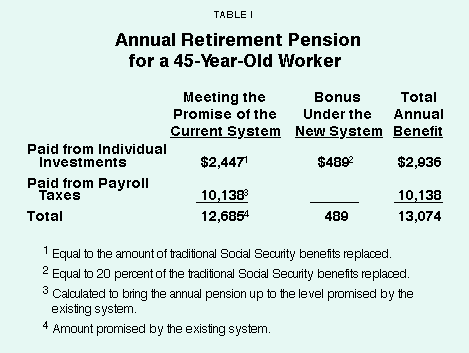
"Under Investment-Based Social Security, workers are assured benefits at least equal to those the current system provides."
Each individual worker owns the funds in his or her SI Account. Upon retirement, the worker's SI Account will be supplemented by the current system if the amount of monthly income provided to the worker by his SI Account is less than what he would have received from the current system, plus a bonus of 20 percent. Younger workers who are in the investment-based system their entire lives will, on average, receive more than 120 percent of the benefits promised by the current system from their SI Accounts and therefore will not need a supplement from the current system unless they experience a lifetime of low wages or long periods of unemployment. Workers who enter the investment-based system late in their working lives will not have sufficient time to build up a large SI Account, so they will receive a supplement from the current system. The supplement will be calculated so that the worker's total monthly benefit equals the amount promised by the current system plus 20 percent of the annuitized value of the SI Account.
Retirement Annuities. Workers who choose to participate in the new, Investment-Based Social Security system will, upon reaching retirement age, be required first to use their investment funds to buy a Social Security Individual Investment Annuity (SI Annuity). To qualify, an SI Annuity will have to provide a monthly income that is guaranteed for the remainder of the retiree's life.6 The SI Board will set standards for SI Annuities, which their sellers will be required to meet.
"Part of the individual investment account will replace benefits currently promised; the remainder will constitute a bonus of 20 percent."
When the investment-based system is fully phased in, each retiree will be required to purchase an SI Annuity that provides a monthly payment equal to the Social Security benefit promised under current law plus 20 percent. Any funds in the retiree's SI Account above that amount can be withdrawn by the retiree in total or in part and used for any purpose.7 The gains that will accrue to the SI Account over the life of the investment will not be subject to taxation until the employee retires. The income received from the SI Annuity will be treated for tax purposes like income received from the current Social Security system. Any funds in an SI Account not used to purchase the required SI Annuity or pay for other current law benefits will be taxed as investment income at the time of withdrawal.
"At retirement, individuals will convert their investment accounts into annuities that pay a monthly pension benefit."
Retirement Benefits under the New System. Consider a 20-year-old worker who begins in the year 2000 to invest three percentage points of his 12.4 percent payroll tax in an SI Account. Suppose that the worker's wages over his working life average $30,000 a year, adjusted for inflation. Based on historic rates of return, the worker can expect a net average annual real rate of return of 5.3 percent, net of management fees. When the worker reaches age 67,8 his SI Account will be valued at $175,372 – allowing him to purchase a Social Security Annuity paying $15,486 annually, which is 23 percent more than the $12,585 the current Social Security system would have provided.9 If a young worker enters the labor force after the year 2000 and due to low wages or unemployment builds up an SI Account insufficient to pay the promised benefit of 20 percent of his SI Annuity plus the current Social Security payment, the Social Security system will supplement his SI Annuity by the amount required to provide the guaranteed benefit. The same guarantee will apply to any worker whose SI Account earnings are insufficient to pay the 20 percent bonus and the benefit that could be expected under the existing Social Security system.
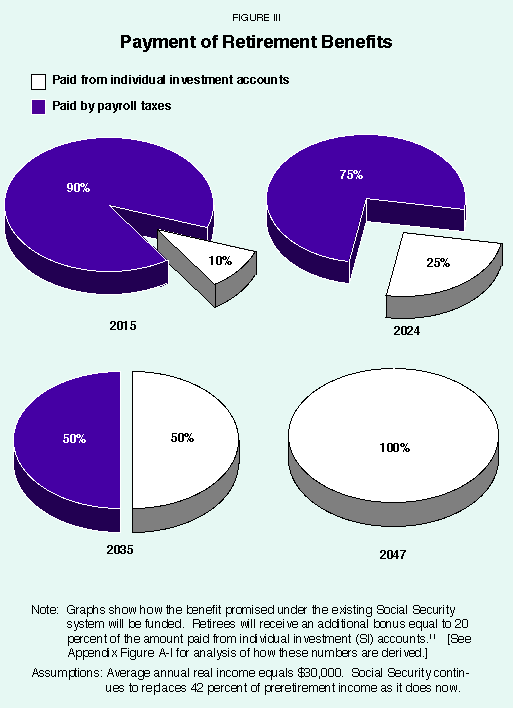
Retirement Benefits during the Transition. During the transition period, those workers who are older when they join the new system will have a shorter period of time to invest before reaching retirement age. As a result, funds in their SI Account will be insufficient to fully fund their retirement. In such cases, the workers will draw retirement benefits in part from the existing Social Security system and in part from their own SI Annuities.
"The portion of retirement income funded by individual savings will grow from 10 percent in 2015 to 50 percent in 2035 to 100 percent by 2047."
For example, a 45-year-old worker who joins the investment-based system in 2000 and who has real average earnings of $30,000 will build up an SI Account of $33,249. This amount is large enough to purchase an annuity of only $2,936 per year. Yet the promised benefit under the current system is $12,585 a year. In addition, retirees in the investment-based system are guaranteed they will never receive less than they would have received under the old system plus 20 percent of the SI Account investment buildup. Under the transition plan, therefore, the worker will receive an annual retirement pension of $13,074. The extra $489 is the worker's bonus, which equals 20 percent of the amount of retirement benefits funded by his investment annuity. The investment annuity pays the $489 bonus and replaces $2,447 of tax-funded benefits, for a total of $2,936 per year. The remaining $10,138 per year will be paid from payroll taxes under the existing Social Security system. [See Table I.]
With each year that passes, new retirees will get an increasing share of their retirement income from their SI Annuities rather than from the existing Social Security system.10 Figure III shows how the percentage of Social Security benefits paid by the payroll tax declines over time for an average worker who earns $30,000 a year in inflation-adjusted dollars. Those retiring in 2000 will have built up no investments and their Social Security benefits will be paid entirely out of the existing Social Security system by payroll taxes. The first baby boomers (those retiring in 2015) will have built up an SI Account that will displace 10 percent of the Social Security benefit that would have been funded by payroll taxes and fund a 2 percent bonus as well. The 10 percent funded by the SI Account instead of payroll taxes is permanent and never again will workers have to pay a payroll tax to fund that portion of Social Security benefits for those retiring in 2015.
By 2024, the average worker earning $30,000 will have built up investments large enough to pay the 20 percent investment bonus, which will equal 5 percent more than his expected Social Security benefit, and still displace 25 percent of the cost previously borne by the payroll tax. By 2035, the last baby boomers' SI Accounts will fund a bonus equal to 10 percent of the Social Security benefit provided by the current system and displace 50 percent of the cost of funding current benefits. By 2047 and beyond, retirees will receive a full 20 percent investment bonus and their SI Accounts will fully fund their Social Security.
"Under an investment system, the worker rather than the government will choose when to retire."
Freedom to Retire. In order to control the cost of federal retirement programs, the government has established 65 as the retirement age for workers who receive full benefits. When the Social Security system edged toward bankruptcy in the late 1970s, the government responded in 1983 with legislation that will gradually increase the retirement age from 65 to 67. Similarly, some are now proposing to raise the retirement age to 70. Under a fully implemented investment-based system, however, the worker rather than government will choose when to retire. Workers can retire at any age once they have built up a large enough SI Account to fund benefits equal to 120 percent of the Social Security benefit promised at the normal retirement age and fund any survivors, spousal or other benefits that might be triggered by their retirement.
"Once the new system is fully phased in, workers will be able to invest 8 percent of their wages and receive benefits 2 1/2 times as large as what the current system promises."
Nothing in the Investment-Based Social Security system will alter the rules governing early retirement at age 62 under the current system. Workers who choose to participate in the investment-based system will have the right to retire at 62 with a benefit during the transition at least equal to their early retirement benefit under the current system plus 20 percent of their SI Fund.
[page]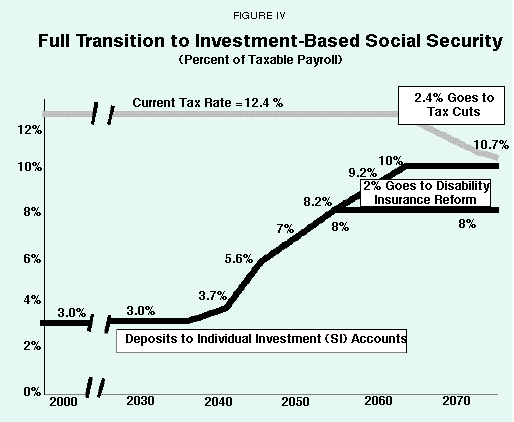
The Investment-Based Social Security system will become self-financing by 2038. [See the discussion below.] Therefore, beginning in 2038 the amount of the 12.4 percent payroll tax going into real investments can begin to rise above the initial three percentage point level. As shown in Figure IV, the percentage of wages flowing into real investments through SI Accounts can rise over time, reaching a level of 8 percent around 2055. An additional 2 percent of payroll pays for disability insurance, and the payroll tax rate can be reduced over time from 12.4 percent to 10 percent. When fully phased in by 2055, the rate of real investment will be 8 percent of wages, yielding an expected basic benefit 2.5 times the amount promised by the current Social Security system for an average worker. The payroll tax will begin to decline after 2065 and reach the permanent level of 10 percent, thereby giving workers a 19 percent reduction in their Old Age Survivors and Disability Insurance (OASDI) taxes. By contrast, to maintain the solvency of the current Social Security system after 2065, we would be forced to raise the payroll tax by 48 percent or cut benefits by 33 percent.
[page]In addition to retirement benefits, the Social Security payroll tax also funds family and survivors benefits and disability insurance. Those who elect to participate in the Investment-Based Social Security system are assured that these other benefits will be at least as great as under the current system.
"Family and survivors benefits will be at least as great as those currently promised."
Family and Survivors Benefits. Today, spouses (including some former spouses) and dependent children of retired workers receive a family benefit equal to 50 percent of the retired worker's expected Social Security benefit. At age 65, surviving spouses receive 100 percent of the deceased worker's expected Social Security benefit, with lower amounts paid to younger surviving spouses, dependent children and dependent parents. The total amount of benefits paid to all family members is capped at 188 percent of the retiree's base benefit, with additional amounts available for divorced spouses who were married to the retired worker for at least 10 years. Upon the worker's death, the surviving spouse or children receive a one-time, lump sum death benefit of $255. Also, family and survivor benefits are reduced dollar for dollar by the amount of Social Security benefits earned in the spouse's or child's own name.
These benefits will continue to be paid under the new system, but the source of funding will gradually change. After the percentage of the payroll tax dedicated to SI Accounts has risen to 5 percent, the SI Annuity purchased at retirement will begin to cover part of the cost of family and survivor benefits. When workers are contributing at least 7 percent of their wages to their SI Account throughout their working lives, their SI Annuity will fully fund these benefits. Any shortfall will continue to be financed by the Social Security system. If the worker dies prior to retirement, the worker's SI Account, minus the present value of benefits promised to surviving family members under the current system, will be given to the worker's heirs in a lump sum free of any taxes.
"The aggregate level of individual investment accounts will grow to $1.6 trillion in just 10 years."
Disability Insurance. All new workers who enter the labor force after the year 2055 will transition into a new Cooperative Disability Insurance System, a private cooperative owned by workers and run by private insurance companies under the supervision and regulatory oversight of a Disability Insurance (DI) Board. The DI Board will be composed of the Secretary of Labor, the Secretary of the Treasury, a state insurance commissioner and two outside members who are experts in disability insurance, one of whom will be chairman. The two outside experts and the state insurance commissioner will be nominated by the president and confirmed by the Senate to staggered six-year terms.
[page]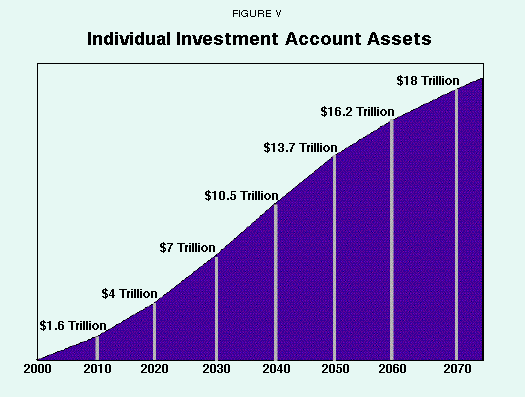
Over a fairly short period of time, it seems probable that virtually every worker will opt into the investment-based system. Figure V shows the buildup of investment assets, net of retirement benefits paid, assuming all workers participate. The aggregate level of SI Accounts begins at zero in 2000 and grows to $1.6 trillion in just 10 years. The amount of assets builds up at an accelerating rate, reaching $10.5 trillion in 2040 and growing at a slower rate thereafter. The data on which Figure V and all other figures in this analysis are based are presented in Tables A-I and A-II in the appendix.
"By the year 2031, the cost of the new system will equal its benefits."
Figure VI shows the costs and benefits of transitioning from the existing debt-based system into an Investment-Based Social Security system. In the year 2000, the existing Social Security system will cost $394 billion. To maintain that level of funding and, at the same time, allow workers to invest 3 percent of wages in their SI Accounts will cost an additional $106 billion. The cost of the existing Social Security system is slated to rise to $699 billion in 2020. By that time, the investment-based system needs only an additional $92 billion to allow a real investment of 3 percent of wages and still pay the benefits of the existing system. The reason less additional funding is needed: roughly 20 percent of all benefits to new retirees in that year will be paid for by investments they made over the previous 20 years. By the year 2031, the investment-based system will cost roughly the same as the existing system. By 2040, 80 percent of the benefits paid to new retirees will be paid for by the investments they have made over the previous 40 years and the earnings on those investments. In that year, the cost of the existing system would have risen to $1,030 billion while the cost of the investment-based system will be only $920 billion.
"In the long run, there are no net transition costs; but there is a cash flow problem during the first 31 years."
By the year 2050, the cost of the existing Social Security system would be $1,150 billion and rising, whereas the cost of the new investment-based system would be back down to $861 billion and falling. In that year, the retirement benefits of the average new retiree would be fully funded through his or her SI Annuity. The remaining cost to taxpayers would consist of paying benefits to people who had retired previously, paying minimum benefits to those whose SI Annuities fall short of the guaranteed minimum and paying survivor and other benefits.
The initial transition costs of moving to an investment-based system are illustrated in Figure VI. The transition cost is 3 percent of wages in 2000 and declines to zero in 2031. In each of these transition years, the cost of the new system will exceed the cost of the existing system. But as worker investments build up under the new system and begin to fund retirement benefits, the transition cost falls off sharply. From the year 2031 on, the cost of the new system declines relative to the old system as real investments fund an ever-larger share of Social Security benefits. The cost of the existing system continues to rise because all benefits must be paid for with taxes on the wages of workers who are declining in number relative to the number of retirees. The benefits of moving to the new investment-based system beyond the year 2031 are also measured by the area between the two lines. Over time, the benefits of moving to an investment-based system greatly exceed the costs of the transition.
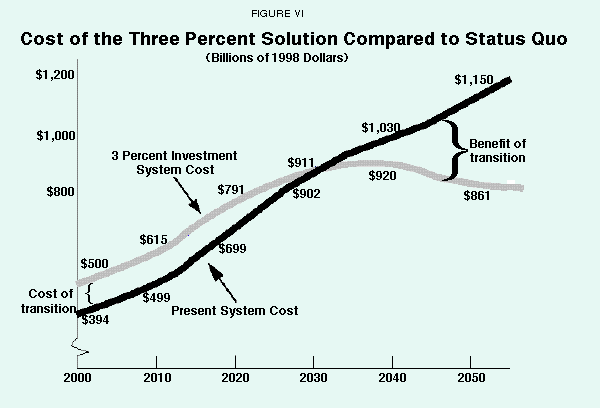
The Cash Flow Problem Associated with the Investment-Based System. From the previous analysis it is clear that, over any extended period, substantial savings accrue as a result of instituting an investment-based system and harnessing the power of compound interest to pay future benefits. In that sense, over a long period of time, there are no net transition costs in moving from the current debt-based system into an investment-based system. In fact, there are substantial savings. There is, however, a cash flow problem since the cost of moving to the investment-based system occurs in the first 31 years of implementation and the benefits flow in every year thereafter. Any serious proposal to institute an investment-based system for Social Security must contain a program to fund this cash flow problem.
"The funding gap under the current system appears in 2013 and continues to rise permanently."
Figure VII shows the cash flow problem associated with transitioning to an investment-based system. The cost of allowing workers to invest 3 percent of wages in their individual SI Accounts is $106 billion in the year 2000. Over time, two factors affect the cost of the transition. First, the growth in the labor force and the growth in real wages causes the 3 percent investment of wages to rise slightly in inflation-adjusted dollars. Second, as real investments build up over time, they pay more and more Social Security benefits and thereby lower the transition costs. As shown in Figure VII, the transition cost begins at $106 billion in 2000, rises to $116 billion in 2010 and falls to $92 billion in 2020.
"The total transition cost rises as the number of retiring baby boomers grows, but total cost then falls as the Investment-Based system pays for more."
By 2031, the buildup of SI accounts will fund a large enough share of total Social Security liabilities so that the benefits of the investment-based system fully offset its costs. Therefore, in 2031 the funding of the transition to an investment-based Social Security system is complete. By 2040, the investment-based system will generate a surplus of $110 billion in real, after-inflation dollars. By 2050, that surplus will rise to $289 billion.
The Cash Flow Problem Created by the Rising Cost of Baby Boom Retirement. Figure VII shows the magnitude of the transition cost to an investment- based system relative to the cost of maintaining the status quo. But it does not answer the all-important question of how to fund the rising retirement cost built into the current system. In fact, the status quo under the current system will require massive increases in the payroll tax or deep cuts in benefits or some combination of the two. Figure VIII shows the funding gap faced by the current Social Security system if benefits are not cut and if the payroll tax is not increased. The funding gap appears in 2013 as the first wave of baby boomers starts to retire. By 2020 the funding gap reaches $104 billion. The funding shortfall of the current system rises to $237 billion in 2030, to $281 billion in 2040 and continues to rise on a permanent basis.
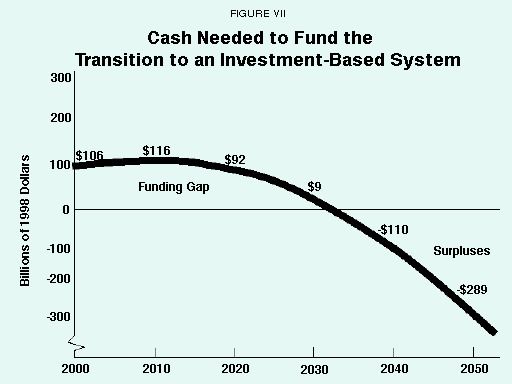
"The transition will be complete by 2053, and the system will be in surplus."
If we are to fund the transition to an investment-based system and the baby boomers' retirement under the current system without either cutting benefits or raising payroll taxes, the total cash flow problem is the sum of Figures VII and VIII.11 This is shown in Figure IX. The total cost measured in after-inflation dollars rises as total real wages rise and as the 77 million members of the baby boom generation make ever-growing pension demands on the current Social Security system. The total cost falls over time as the investment-based system pays for an ever increasing share of Social Security pension costs. By 2053, the transition is complete and the investment-based Social Security system is in surplus.

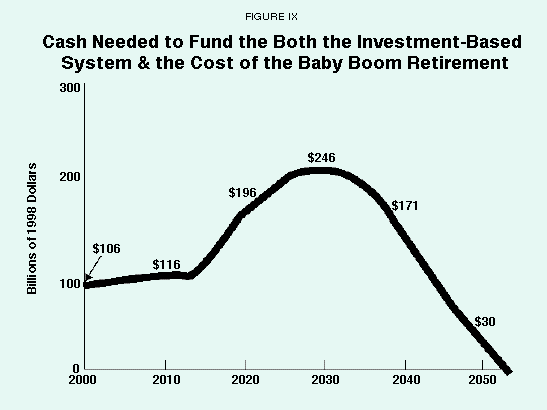
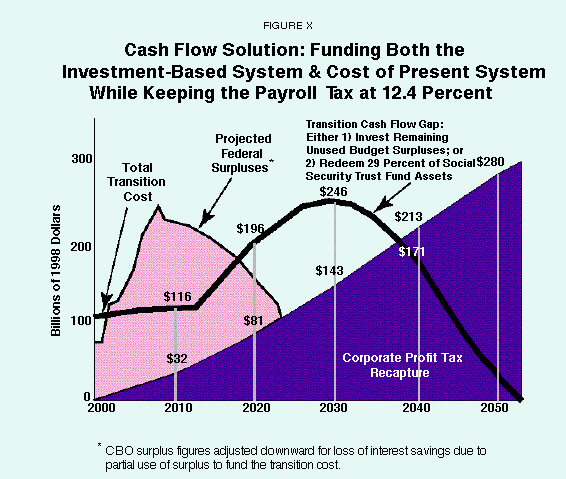
Figure X shows the total cash flow required to fund both the transition to an investment-based system and the cost of funding the baby boom retirements taken from Figure IX. The shaded areas of Figure X identify funding sources for the transition.
Corporate Profit Tax Recapture. As noted above, Feldstein and Samwick have calculated that investors in the private capital market earned a real rate of return of 5.5 percent over the 67-year period from 1926 to 1992. The rate of return actually paid by the capital market over that period was a much larger number: 8.5 percent. As shown in Figure XI, no investor ever saw this 8.5 percent real rate of return, however, since 24.7 percent or 2.1 percentage points was lost to federal corporate income taxes and 10.6 percent or 0.9 percentage points to state and local taxes.
"Transition funds come from: (1) recapture of corporate profit tax, (2) the federal budget surplus and (3) redeeming 29 percent of the trust fund's assets."
Feldstein and Samwick argue that it would be desirable to exempt Social Security investments from the federal corporate income tax to give retirees the full benefit of their investment income. However, there is no practical way of doing this. It is conceptually possible, though, to earmark for the Social Security system a conservative estimate of those federal corporate income taxes collected solely on the earnings of new investments funded by individual Social Security investment accounts. Through a process we will call recapture, the tax revenues will be collected by the Treasury and remitted to the Social Security system, just as taxes on existing Social Security benefits are now earmarked for Social Security. These are new revenues on new investment that would not exist except for the new Investment-Based Social Security system.
The recapture rate is based on the assumption that 80 percent of the funds going into Social Security investment accounts will be net additions to national investment (20 percent will be offset by reductions in other forms of savings and investment).12 It is further assumed that 10 percent of the Social Security investment funds will be invested abroad and so not subject to U.S. corporate taxes and that 5 percent of the investments will escape corporate taxes (subchapter S corporations taxed as individuals, for example).
"Recapture will apply only to new investment occurring as a result of the new system."
These assumptions reduce the effective federal corporate tax rate recapture to 23.9 percent, down from the statutory level of 35 percent. Each year, the level of federal corporate taxes collected on Social Security investment will be estimated by taking the actual returns earned by Social Security investment accounts, prior to all taxes, and multiplying the dollar value of those returns by 23.9 percent. At the end of each fiscal year, this estimated amount will be transferred by the Treasury to the Social Security system. The recapture will apply only to the new investment occurring in the economy as a result of investment-based Social Security and will not significantly alter the amount of corporate taxes that would have been collected in the absence of an investment-based system.
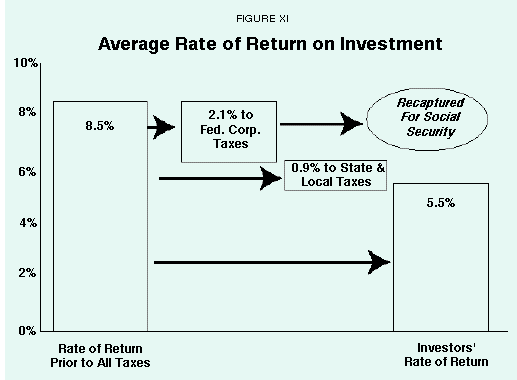
Though small at first, federal corporate tax collections on SI Account investments will grow as the level of investment in SI Accounts build up. The corporate profit tax recapture is shown in Figure X. Recapturing federal corporate profit taxes on SI Account investments for the Social Security system provides a funding source that grows from zero in 2000 to $81 billion by 2020, to $143 billion in 2030 and to $280 billion by 2050 as the level of SI Account investments builds up to $4 trillion, $7 trillion and $13.7 trillion respectively.
Federal Budget Surpluses. The Congressional Budget Office (CBO) now projects a cumulative federal budget surplus of $2.2 trillion over the next decade.13 That surplus, which will persist until after 2020 but decline as the baby boom generation retires, is shown in light shading in Figure X. The CBO-projected surplus, when added to the corporate tax recapture, will fully fund the transition cost to an Investment-Based Social Security system and the baby boom cost explosion through 2017. If the projected surplus of $63 billion in FY 1999 was impounded now and rolled into 2000 to help fund the transition, the CBO-projected surplus would be even larger.
If only the portion of the budget surplus needed in each fiscal year to fund the transition were dedicated to that purpose, a total of $1.11 trillion be required. The remainder of the surplus could be used for other purposes. If the surplus above the amounts needed in each fiscal year to fund the transition were rolled forward to fund the transition in future years, the CBO surplus and the corporate income tax recapture alone would roughly fund the transition.
"The federal government will have to repay 29 percent of the money borrowed from the current Social Security system."
Redeeming Assets of the Social Security Trust Fund. Assuming that only the portion of the annual surplus needed to fund the annual transition cost in each year is dedicated to that purpose, it will be necessary to require the federal government to repay the Social Security Administration approximately 29 percent of the money it has borrowed from the system since 1983 in order to fill the funding gap. That repayment, $1,594 billion, would average roughly $84 billion per year over 19 years.14
By using part of the projected CBO budget surpluses, redeeming 29 percent of the Social Security Trust Fund and recapturing the net new corporate profit taxes flowing to the federal government from taxing Social Security investment income, we can fund both the transition cost and the built-in cost of the baby boom retirement explosion of the present system without cutting benefits or raising payroll taxes.
[page]America is about to enter a new millennium. While the promise of that new era seems secure for the first decade, increasing uncertainty hangs over every year thereafter. That uncertainty is the burgeoning cost of entitlements that begins when the baby boom generation starts to retire. Social Security's bankruptcy won't be just a financial crisis, it will be a human tragedy, not unlike the turmoil of the Great Depression.
After all the revenue projections, demographics and benefit calculations, the funding crisis of Social Security under the status quo boils down to two bad choices: America will have to choose between lost opportunity for our children and abandoned security for our parents. If we choose the path of higher taxes, a tax rate that was 2 percent on our parents will be 18.4 percent on our children. With Medicare, the payroll tax will almost certainly exceed 30 percent.
"If America retains the current Social Security system, it will be forced to choose between lost opportunity for our children and abandoned security for our parents."
Choosing higher taxes means our children's and grandchildren's future will be marked by crumpled resumés, rejection notices and pink slips. It will be jobs they hoped for but didn't get, raises they needed but were denied and advancements they earned but couldn't achieve. If we choose the path of reduced benefits, retirement benefits will be cut by a third or more. That path means our parents' future will consist of discarded financial plans, harassing calls from bill collectors and penny-pinching at the grocery store. It will be dream vacations canceled, deserved retirements delayed and favorite hobbies and activities abandoned.
Think about American families in which two of our most powerful human emotions are pitted against each other: the desire to do anything to help our children get ahead and the determination to provide security and dignity for retired parents.
Children versus parents, grandchildren versus grandparents, the dreams of our children versus the security of our parents – this is what the battle for Social Security will entail. And it will be waged by real people through sleepless nights of worry, around kitchen tables where, despite boundless imagination and ingenuity, the pencils, papers and calculators of breadwinners cannot navigate the barriers erected by government policies which, however well intended, are failing.
"There is a better way: Doing what Social Security promised but never delivered."
There is a better way. It requires doing what Social Security promised but never delivered. It requires that we employ one of the fundamental principles outlined by Franklin Roosevelt for Social Security: "Compulsory contributory annuities which in time will establish a self-supporting system for those now young and for future generations." It requires that we do what the Finance Committee chairman, Sen. Pat Harrison, called for in the original Social Security debate: "[an] annuity system [that] will give to the worker the satisfaction of knowing that he himself is providing for his old age." It requires that we save and invest now rather than tax and borrow later. But it is not just money at stake here. Save today and we save our children's dreams tomorrow. Invest today and we invest in our parents' security. Tax tomorrow and we diminish our children's future, cut benefits tomorrow and we harden our parents' retirement.
NOTE: Nothing written here should be construed as necessarily reflecting the views of the National Center for Policy Analysis or as an attempt to aid or hinder the passage of any bill before Congress.
[page]- While this analysis contains a concrete proposal and a comprehensive computer simulation, it should be viewed not as an implementation plan but as a feasibility study. It seeks to show that an Investment-Based Social Security system can work and that the transition costs are fundable at levels of investment that can make Social Security permanently solvent. Much more work is required to convert this feasibility study into an implementation plan, and its use of simplifying assumptions and first approximations is readily acknowledged. The author is currently working with Sen. Pete Domenici and others to develop legislation to implement an Investment-Based Social Security system. The author is an economist and a senator from Texas.
- The investment options included the Standard and Poor's (S&P) stock indices, an index of the 20 percent of companies listed on the major stock exchanges with the smallest capitalization and the Salomon Brothers Long-Term High-Grade Corporate Bond Index. The investment portfolio was invested: 40 percent in the S&P Index, 20 percent in small company stocks and 40 percent in long-term high-grade bonds.
- See Martin S. Feldstein and Andrew A. Samwick, "The Economics of Prefunding Social Security and Medicare Benefits," Working Paper 6055, National Bureau of Economic Research, Cambridge, Mass., pp. 8 – 9.
- It is probable that funds managing Social Security investments would initially lose money while investment accounts are small but become profitable as investment accounts build up. If a maximum management fee were established by the Social Security system, it would reduce the use of aggressive sales forces and excessive churning of accounts.
- The SI Board will coordinate the examination activities of the existing federal regulatory agencies overseeing the various financial institutions certified to serve as Qualified SI Funds. Actual examination of the SI Funds for compliance with safety and soundness standards will be conducted by the agency that chartered the institution serving as an SI Fund and which supervised its other activities.
For example, in order to ensure compliance with the standards and rules established by the SI Board, the Securities and Exchange Commission, which now examines and supervises mutual fund and other investment companies, will directly examine and supervise the mutual funds and investment companies that become Qualified SI Funds and manage SI Accounts. Similarly, the bank regulators, such as the Comptroller of the Currency, state banking authorities, the Federal Reserve Board and the Federal Deposit Insurance Corporation, will monitor the activity of any banks under their supervision that offer SI Accounts.
- The annuitization of the SI Accounts is based on the assumption that the investments earn returns in the annuity similar to those received in the SI Accounts. This is a simplifying assumption which will have to be corrected as a full-blown annuity market develops and the actual cost of the insurance component of the annuity becomes known. Today's annuity market is so underdeveloped as to render existing cost data of little use as a guide for a full-blown system.
The conversion of the SI Account to an SI Annuity could follow the variable annuity model used by the Teachers Insurance and Annuity Association-College Retirement Equities Fund (TIAA-CREF). At the time of retirement, the initial payment from the SI Annuity would be a monthly amount that would completely exhaust the available funds over the normal remaining life expectancy for the retiree at an expected rate of return net of administrative costs. The rest of the retiree's retirement benefit would be paid by the current system.
In subsequent years, the actual payment from the SI Annuity would be adjusted based on the performance of investments held by the annuity and based on changes in life expectancy for the retiree's age group. Regardless of the amount of the SI Annuity payment in any given year, however, no one will ever receive less than they are promised by the current system, and each retiree will receive a bonus equal to 20 percent of their SI Annuity payment in that year.
TIAA-CREF's variable annuity carries a 37 basis point administrative charge, almost twice the 20 basis points assumed in the analysis above, possibly because it only has $621 million in its annuity program.
- Including survivor benefits to be discussed below.
- Under current law the retirement age will begin to rise in 2003 and reach 67 in 2027.
- Unless otherwise stated, all figures are in inflation-adjusted dollars.
- See Tables A-I and A-II in the Appendix.
- While this analysis seeks to show the feasibility of transitioning to an investment-based system without raising payroll taxes or cutting benefits, either action makes the achievement of a permanent solution easier.
- It will take almost 50 years for the buildup of individual investment accounts to yield a retirement benefit 20 percent above the level promised by the existing Social Security system. It seems improbable that workers who enter the investment-based system will reduce other savings by more than that 20 percent in response to the buildup of wealth in their individual Social Security investment accounts.
- This number assumes an extension of the existing caps on discretionary spending.
- Since an investment-based system requires real investment, if the federal government funds part of the transition by paying back 29 percent of what it has borrowed from the Social Security system, such funds must be obtained by spending cuts or tax increases. If the federal government simply borrowed the money from the public, the funds going into the system would not be net new investment.
